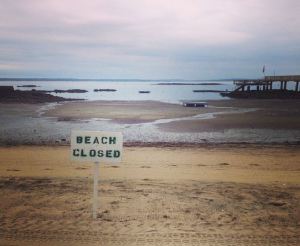Our new interactive map explores health of beaches around the Sound
Many beaches around Long Island Sound suffer from unsafe bacteria pollution due to sewage contamination. For the first time, we are able to map historical patterns of contamination at individual beaches and see a complete, Sound-wide picture of bacterial pollution, thanks to our brand-new, interactive web map: the Sound Health Explorer! Our goal is to make water quality data accessible to everyone—scientists, elected officials, and public alike. Armed with this information, citizens, municipalities, and state governments can identify health dangers at local beaches and begin the process of fixing them. The Sound Health Explorer grades beaches around Long Island Sound on an “A” to “F” scale. Each grade is based on how often over the last decade a beach has failed U.S. Environmental Protection Agency (EPA) bacterial pollution standards for safe swimming. This will allow communities to target resources to the swimming hotspots that are most risky.
The Sound Health Explorer grades beaches around Long Island Sound on an “A” to “F” scale. Each grade is based on how often over the last decade a beach has failed U.S. Environmental Protection Agency (EPA) bacterial pollution standards for safe swimming. This will allow communities to target resources to the swimming hotspots that are most risky.
Health risks from unclean beaches
Health risks associated with swimming in waters contaminated with fecal bacteria include viral, parasitic, and bacterial infections. Common illnesses include diarrhea, pink eye, ear infections, and skin irritation, but even more serious problems can occur too, especially in children, the elderly, and individuals with weakened immune systems.
Telling local stories

We think the most exciting feature of the Sound Health Explorer is the ability to identify local problems—and then use that knowledge to find local and regional solutions. Without access to reliable data, water pollution can remain mysterious and out of reach. But with the data provided by the Sound Health Explorer, communities can find and tackle the pollution at their beaches, because sources differ around the Sound.
Causes of fecal bacteria contamination vary around the Sound. The most common sources include leaking sewer lines, failing septic systems and cesspools, combined sewage overflows in older cities, and polluted stormwater runoff that delivers fecal contaminated water (as well as other pollutants) from the surrounding area into our waterways.
Connecticut
In one of the examples from Connecticut, the Sound Health Explorer shows an across-the-board decline in water quality between Norwalk and New Haven over the past five years (from 2010 to 2014) when compared to the previous five years (from 2004 to 2009). Look for a detailed blog post from us next week that will delve into this story in more detail! One common source of fecal contamination in the waters of the Sound along Connecticut’s coast is combined sewer overflows that allow untreated sewage from the stormwater and sewage treatment systems to enter our waterways and eventually the Sound.
Westchester
In Westchester, Glen Island Park in New Rochelle and Rye Town Beach in Rye are among the most reliably clean beaches, while Shore Acres in Mamaroneck and Surf Club in New Rochelle both frequently exceed bacteria limits and received a failing grade. Common pollution sources in Westchester include sanitary sewer overflows, where sewage is discharged into the environment before treatment at a sewage treatment plant. Old, cracked pipes and broken-down sewage infrastructure are major problems that contribute to fecal bacteria in the Sound.
Long Island
On Long Island, Theodore Roosevelt Beach in Oyster Bay is among the most reliably clean, while neighboring Beekman Beach frequently exceeded bacteria limits. A common pollution source on Long Island is leaky or improperly maintained septic systems and cesspools.
What YOU can do!
- Talk to your local elected officials and Department of Health. Tell them what you’ve learned about how often your beach fails EPA guidelines for safe swimming. Ask them to identify local sources of pollution and to invest in local wastewater infrastructure to keep the sewage in the pipes!
- Make sure the sewer line connected to your home, or your septic system or cesspool, is in good working condition and properly maintained.
- Keep stormwater on your property by planting rain gardens and support local green infrastructure projects that will prevent runoff pollution by letting stormwater soak into the ground.
- If you notice a sewage leak or overflow, send photos and documentation to us at pollution@savethesound.org.
- Become a member of Save the Sound and support our regional initiatives to clean our beaches!
Remember, Long Island Sound has many beaches that are tested frequently and are reliably safe to swim at. You should enjoy them! Save the Sound’s goal is to make every beach safe and healthy, every day. Together, we can fix all of them and Save the Sound.
